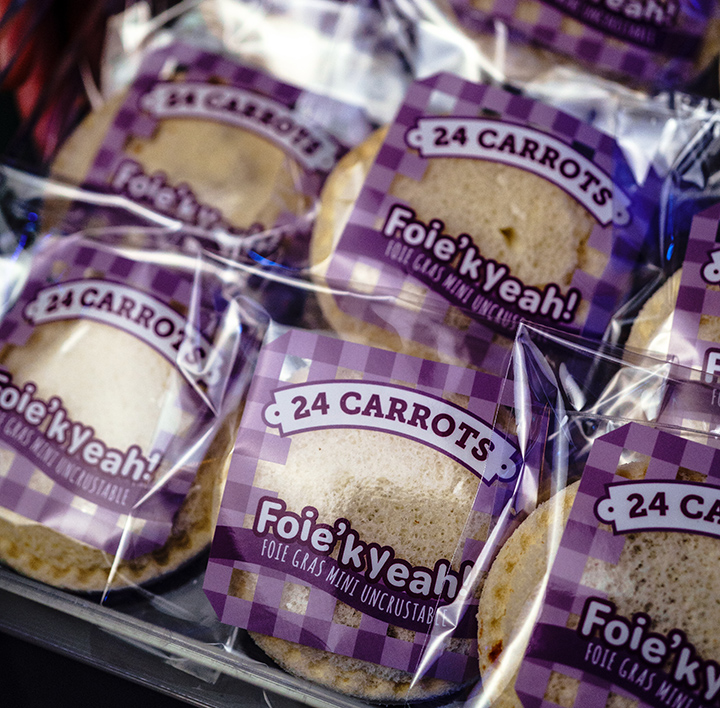“I promise you,” said entrepreneur Gary Vaynerchuk, CEO of VaynerMedia and VaynerX at Catersource’s Q4 sister show, MUFSO, “in a decade to 15 years, your brand is the only thing that will matter besides the quality of your product. …You need to operate on the reality of the consumer—not the nirvana of ‘how I want the world to operate.’”
Why would we begin a section on food and beverage trends with a quote such as this? Because to remain viable in a market where consumers want what they want in a very specific way—and don’t care what we must spend to give it to them—now is the time to examine build relevant catering menus for tomorrow’s consumer demographics, and then market that menu (and your company) in a way that resonates to your best advantage. You are first a media company, says Vaynerchuk, and then you are next providing a food and/or event experience.
To that end, building a “story” around your company and its aesthetic toward the services it provides is crucial. “Guests can see through the BS we put out,” said Brian Ingram, a restaurateur in the Minneapolis/St. Paul, MN area, noting that “creating a consistent story, standing for something” and “being purposeful” with food and décor is the best way to win and retain clientele.
You are building the menus for consumers whose mobile devices control their every move—which, as we all well know, puts the world at our fingertips. So, what in the world should you do?
Swimming out of the sea of sameness
Below you will find ideas and examples of food and beverage trends you need to incorporate into your 2020 menus.
Top Trend: Plant based cuisine
From Whole Foods to the Vegconomist, Food Business News, even Grubhub, all state emphatically that the plant-based revolution is upon us. Take heed of the late Q3 2019 launch of Naked Fig Catering, a partnership between Marcia Selden Catering and Chef Matthew Kenney, a renowned plant-based cuisine expert, for example. The company’s entirely unapologetic plant-based menu includes items such as Harissa and Maple Rainbow Carrots with Maple Fluff and Pistachio Dust; King Oyster Bao with Cashew Hoisin and Pickled Cucumbers; and Avocado Tikka “Taco” with Curry Leaf Yogurt, Candy Cane beets, and Affilla Cress Micro.

Naked Fig Catering Signature Grilled Flatbread of Fresh Figs, Raclette Cheese, Baby Arugula, Balsamic Glaze, “Crumbled Feta” and Opal Micro. Photo courtesy Phillip Van Nostrand
Plant-based fare speaks solidly to the trend in overall consumer health improvement goals, and the charge for fresh food options and ingredients (is it clean? Are there any artificial ingredients?), but also sustainability, support of food supply chains, regenerative agriculture, composting, and steps to limit food waste.
For example, replacing meat-heavy menu choices with Earth-friendly, plant-based options can reduce the carbon footprint of a 500-person event like a conference or large wedding by 10 tons of greenhouse gas equivalents, according to an analysis by the Center for Biological Diversity.
Registration is NOW OPEN for Catersource 2020, co-located with The Special Event! Click here for more information or to register!
The Center’s report, Catering to the Climate, released in December 2019, evaluated the environmental impact of common event menus as well as plant-based alternatives. The results show that offering low-impact menus for 500 attendees can save five acres of habitat from animal agriculture, avoid greenhouse emissions equivalent to those created by driving a car 22,000 miles, prevent 17 tons of manure pollution, and conserve nearly 100,000 gallons of water from irrigation and food processing.
“Public demand for plant-based, low-carbon menus is growing quickly,” said Jennifer Molidor, senior food campaigner at the Center and one of the report’s authors. “Even small changes in purchasing, like replacing dairy with plant-based milks and cheeses, can bring substantial benefits to suppliers and their clients. When the event and catering industry serves plant-based menus, it’s an environmental and culinary success.”
Term changes
Change your terminology when proposing an all-plant menu: For food flexitarians who are happy to eat vegetables one day, a blended burger the next, and center of the plate meat the next, the term “plant-based” appears more nuanced, perhaps more forgiving than “vegetarian” or “vegan”—which infer stricter dietary regimens.
Additionally, the dulcet call of “farm-to-table” speaks to gardens and growing; but can also imply there is meat involved. If you feel your menu fits this type of aesthetic, use this terminology when the offerings are flexible.
And then there are the rest of the trends…
Grazing stations. “It’s not like what you’re thinking,” says Chef Keith Lord of Stratəjē Fourteen, formerly The Wild Thyme Company. “Think tables of kabobs, salads, sauces, and breads where the food is the décor. No chafing dishes. Use your beautiful food as your décor and be creative in your approach with it,” he says.
Another example: It’s no longer a cheese board, as the Diary Farmers of Wisconsin showed at the annual International Foodservice Editorial Council conference in October 2019, it’s a long cheese table with selections such as figs, fruit, varied breads and crackers and chutneys drawing the guest in and encouraging them to linger—and mingle with others.
Branded beverages. How often have you seen a beautiful beverage photo on Instagram? Oh, the garnish, the vessel, the logo’d bespoke ice cube. But best, says Florida caterer, Bill Hansen, are the “imaging systems where you can put a photo of the bride on top of the beverages!” With a sheet of rice paper, a printer, and edible ink loaded into cartridges, any bartender can be an artist, no drawing skills necessary.
“Hack” the high end. Take a page from Carl’s Jr. and elevate a traditional offering, such as taking a bacon cheeseburger and adding truffle. Voila! Bacon Truffle Cheeseburger. There’s your upcharge. Making luxury affordable—and approachable—will win your next Gen Z wedding proposal.
Nostalgic foods & experiences, uplifted. I am not going to point a finger at the “taking a break from ‘adulting’” trend as the reason for a rise in foods and experiences that kindle nostalgic feelings, because this (ahem) older-than-Millennial reporter delights in all foods and fun that remind her of simpler times. Cereal milk rum punch and Froot Loops festooned cocktail glasses delight; giant Jenga games, Merry-Go-Rounds, and swing sets encourage guest interaction, and, as shown in the accompanying photo, who could turn down a foie gras mini “uncrustable?”

From a late Q4 2018 event, Foie Gras Mini Uncrustables. Photo courtesy Villa Visuals and the caterer, 24 Carrots
Functional foods. “This is just starting to take off,” said Jack Li of Datassential, regarding superfoods and ingredients that offer positive nutrition and performance enhancement. Quoting an average consumer, Li continued, “’I want to raise the bar so much that I want food to do something for me… and I’m willing to pay an extra $1 to add it to my smoothie.’” Chia seeds, bee pollen, turmeric, spirulina.
What does the future hold after functional foods take hold? “Personalized nutrition,” says Li. Home DNA tests will not just tell you about your ancestry, but also your health and your taste preferences. How many times have you wandered around your kitchen, rummaging in the fridge, hungry for something, but not quite sure what that something is?
“[The trend in personalized nutrition involves] optimizing food based on personal DNA. Submit it, and they will give you a meal plan.” In Japan, reports Food Dive, there are about 100k participants in a Nestlé pilot program called “Wellness Ambassador” which provides everything from home kits for blood and DNA sampling to AI analysis to tailor its products to meet diet and health specifications. It also helps with the company’s own R&D.
Cuisines on the upswing. Chef Lord cites, “Turkish. High end Japanese. Indian. Tons! More Thali (round platter) and chat style, though.” Li spoke to Hawaiian cuisine as an emerging trend, followed by Ethiopian and also very specifically Levantine cuisine from the Middle East’s Levant region. “Asian sweets are growing: rolled ice cream, egg waffles, bubble waffles, sesame rice balls. What do they have in common? They’re extremely photogenic! Sticky Turkish ice cream. It almost doesn’t matter what it tastes like, as long as it’s photogenic,” said Li.
Learn more at Catersource 2020
From culinary trends to techniques to flavor profiles, Catersource 2020 will have well over 2 dozen sessions focusing on food and beverages. Here are a few to bring to your attention; check out the full schedule online at schedule.catersource.com.
Session 1: Plant-Based Platings: A Trend Retrospective & Revitalization with Joanne Purnell and Jennie Cook, 10:30 to 11:15, Thursday, March 12
Session 2: It’s Flavor, Not Fads: Food Trends in Catering with Nick Weber, 3:00 to 3:30, Thursday, March 12
Session 3: It’s All in the Plating with Keith Lord, 4:15 to 5:00 on Tuesday, March 10




